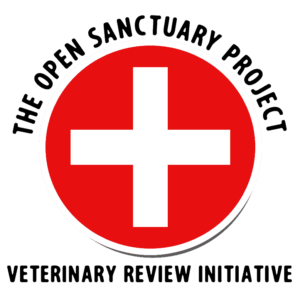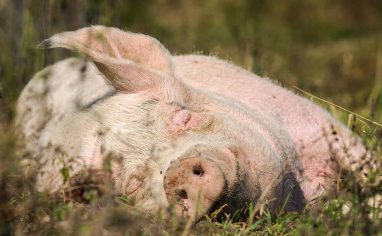
This resource was updated in preparation for veterinary review. It was originally published on December 11, 2018.

Veterinary Review Initiative
This resource was reviewed for accuracy and clarity by a qualified Doctor of Veterinary Medicine with farmed animal sanctuaryAn animal sanctuary that primarily cares for rescued animals that were farmed by humans. experience as of April 2025.
Check out more information on our Veterinary Review Initiative here!
Much like the common advice given to humans, it’s important to regularly check the health of alpacas with a routine health checkThe Open Sanctuary Project uses the term "health check" to describe health evaluations performed by caregivers who are not licensed veterinarians. While regular health checks are an important part of animal care, they are not meant to be a replacement for a physical exam performed by a licensed veterinarian. rather than waiting until an alpaca is showing signs of distress or illness. Not only will this help you get to know what all aspects of a healthy alpaca look and feel like, but it can also help your alpaca residents become accustomed to gentle human handling, which might help them remain calm during other scenarios where restraint or handling are necessary. Be prepared to check them over every six to eight weeks*! For more information on why regular health checks are important, check out our resource here.
A Health Check Every Six To Eight Weeks Means Daily Observation
Our recommendation to conduct routine health checks every six to eight weeks must be done in conjunction with daily observations. Caregivers should be trained to observe animals both for behaviors that are abnormal for the species and also behaviors that are abnormal for each individual, keeping in mind issues that are common in a particular species and their warning signs. Thoughtful observation plays a crucial role in catching health issues before they progress into more serious situations. You can read more about daily observation for alpaca health and well-being here.
Residents With Challenging Backgrounds
Close daily observation can be difficult with certain individuals or groups who come from challenging backgrounds. They may be more likely to hide signs of illness or injury, or may not allow you to come close enough to them to thoroughly assess their well-being regularly. Challenging backgrounds may include individuals who have experienced trauma in the past, which may include – lack of socialization, having lived feral, or being abused or malnourished. If you care for individuals who came from a challenging background, it is imperative to make time to foster a bond of trust so that careful observation is possible. A monthly health check is recommended for these individuals until they exhibit signs that they feel safe and you are confident that close daily observation is possible.
New Resident? Conduct An Intake Evaluation!
If you are conducting an initial health evaluation on a new resident, check out our intake evaluation resource to learn about what you should check for and document!
Supplies
Before conducting a health check, it’s helpful to gather any supplies you may need and have them arranged nearby for easy access. Having everything you will likely need nearby can make the process go more smoothly and will reduce the amount of time the individual must be restrained. If you are performing a health check on someone with a known health issue or detect signs of a certain health condition during the health check, you may need additional supplies besides those listed below. Otherwise, supplies to have on hand during alpaca health checks may include:
- Recordkeeping supplies
- A halter (if using for restraint)
- Nail trimmers
- Gauze squares (non-sterile is typically fine, but there may be times when sterile gauze is necessary)
- Exam gloves
- Camelid-safe topical disinfectant (such as dilute chlorhexidine)
- Saline flush
- Camelid-safe ointments or creams
- Cotton-tipped applicators
- Tweezers
- Headlamp, penlight, or flashlight
- Thermometer and lubricant (good to have on hand in case you suspect someone is ill based on health check findings)
- Towels
- Stethoscope
- Clippers (to remove patches of hair if needed)
- Fly treatments or deterrents (during fly season)
- FAMACHA card (if applicable)
Conducting The Health Check
Ask An Expert
Prior to regularly conducting alpaca health checks, you should have a veterinarian or compassionate care expert give you hands-on training in order to be the best alpaca health advocate possible. Being trained to rapidly distinguish healthy conditions from abnormalities can be crucial in early health issue detection and effective treatment! In addition to hands-on training to assess camelid health, proper training is also imperative to ensure both resident and caregiverSomeone who provides daily care, specifically for animal residents at an animal sanctuary, shelter, or rescue. safety! It’s important to be able to recognize signs of fear, agitation, and serious displeasure so you can take steps to diffuse the situation and keep everyone safe. Alpacas don’t tend to kick often, but they can – kicking both outward like a cowWhile "cow" can be defined to refer exclusively to female cattle, at The Open Sanctuary Project we refer to domesticated cattle of all ages and sexes as "cows." and directly behind them, so it’s important to learn how to safely work around them. You can learn more about camelid body positions and what they mean here, but keep in mind that this is not a replacement for hands-on training!
Before beginning individual health checks (and, if possible, before entering your residents’ living spaceThe indoor or outdoor area where an animal resident lives, eats, and rests.), it’s a good idea to take a few minutes to observe the group. Make note of their behavior, activity level, and general appearance. While each individual is relaxed, look for any sign of tremors, which are typically more difficult to notice when working with individuals up close. If residents are up, observe how they are standing and moving and whether or not they are actively eating. If they are lying down, make note of how they are positioned, whether or not they are chewing cudFood matter that returns from the first stomach compartment back to the mouth for further chewing, and whether or not they are away from the herd or are the only one lying down.
Now is also a good time to observe the respiratory rate of individuals in the herd, since this may become elevated once residents are moved or restrained. While you can certainly assess the respiratory rate for each individual, for starters, you may simply spend a few minutes observing the group, checking to see if anyone appears to be breathing more rapidly or with more effort than the other residents. If anyone jumps out as breathing differently than the rest of the group, you could then take their respiratory rate and further evaluate them during their health check (or, depending on other signs they are presenting, you may opt to call your veterinarian).
To assess an alpaca’s respiratory rate, watch their chest movements, counting how many times their chest expands/contracts over one minute. You want to count each paired expansion and contraction as one respiration. The normal resting respiratory rate for an adult alpaca is between 10-30 breaths per minute. Keep in mind that individuals who are active will have an elevated respiratory rate compared to someone at rest. In addition to being an indication of illness, an elevated respiratory rate can also be indicative of an individual being stressed, hot, or in pain.
During this general observation of the group, watch for anyone who stands out as looking or acting differently from the rest of the herd. While this may not necessarily be an indication of a health concern, it certainly warrants further observation and assessment during the health check.
When In Doubt…
Unless you are a qualified veterinarian or have been trained to handle specific conditions, The Open Sanctuary Project strongly advocates that you promptly report any health concerns you find during a health check to your veterinarian or a care expert. You should be your residents’ advocate, not their doctor. Additionally, routine health checks performed by a caregiver are not meant to be a replacement for veterinary assessment. The goal is to catch potential signs of concern as early as possible so you can bring concerns to your veterinarian. If necessary, they can then perform a more in-depth examination of the individual.
Next, we’ll discuss the important components of a health check. Please note that while these “steps” do not have to be completed in the order listed below, it is helpful to follow a consistent order to avoid accidentally missing a step. Some folks like to start at the feet and work their way up, while others like to start at the head and work their way back.
Body condition scoring can also be a useful tool, particularly if weighing residents is not possible. We recommend working with a veterinarian for proper training in body condition scoring to ensure the most accurate results. However, if you are not trained in body condition scoring, you can still roughly assess their body condition. Because an individual’s hair coat can drastically skew our visual assessment of their body condition, this part of the health check requires a hands-on assessment. A thin individual will have a prominent spine and ribs, whereas in an overweight individual, these will be more difficult to detect.
Be sure to share concerns about a resident’s weight with your veterinarian. Herd-wide issues warrant a closer look at your residents’ diet, but herd-wide weight loss could also be due to contagious disease or parasitism. Isolated instances of weight gain or loss should also be discussed with your veterinarian. There are numerous reasons a resident may be losing weight, which is why it’s important to work with an experienced veterinarian to have the individual assessed. You’ll also want to discuss how the individual is doing overall. Losing weight despite a healthy appetite will suggest different possibilities than weight loss accompanied by inappetence.
Their neck should be straight and held upright (in alpacas, it is typically held at about 70 degrees). Holding the neck and head lower than this may be a sign of weakness. Feel along their neck for any abnormalities concealed by their hair.
Check for a menace response by moving your hand towards each eye a few times (without touching their eyelashes or eyes). Alpacas should reflexively blink in response to this test. You can also use a penlight or flashlight to check that the individual’s pupils constrict in response to bright light and then return to normal. Any concerns about an individual’s eyes should be raised with your veterinarian as soon as possible. They can do a much more thorough examination if needed.
Check the mucus membrane of the lower eyelid to look for evidence of anemiaAnemia is a condition in which you don't have enough healthy red blood cells to carry adequate oxygen to the body's tissues. (pale mucous membranes), which could be a sign of barber pole worm infection or other serious conditions. If you are trained in FAMACHA scoring, be sure to use your card and record their score (please note that your veterinarian may recommend performing FAMACHA scoring more often than just at routine health checks).
Look for excessive drooling or foaming around the mouth. Check/feel their jaw for any lumps, lesions, or areas of swelling or discharge. A lump along the jaw could be a sign of a dental issue. Your veterinarian can perform a dental examination to determine if they require any dental work, and they can also make recommendations if the individual requires dietary changes due to their dental issues. Feel under the jaw for swelling or fluid buildup (bottle jaw). This can be caused by low concentrations of protein in the blood, which may be the result of barber pole worms. Contact your veterinarian if a resident has bottle jaw.
Carefully part their lips so you can see their teeth and gums. Alpacas have three pairs of lower incisors and a dental pad up top. They also have an upper incisor and upper and lower canines that are collectively referred to as “fighting teeth” (though some individuals may have had these removed). While a full dental exam is beyond the scope of a caregiver-performed health check and should be reserved for your veterinarian, you can look for missing, broken, or visibly loose teeth (it will be difficult to assess more than just their front teeth). You can also check their gums, which should be moist and, unless pigmented, should be pink. Red, pale, or tacky gums can indicate a problem.
While checking their mouth, make a note of any abnormal odors on their breath or originating in their mouth. An abnormal odor could be a sign of a respiratory infection, dental issue, or other concern.
In addition to checking for signs of bloat, be sure to feel all around the individual’s sides, underside, and back for any lumps, swelling, wounds, edemaEdema is the abnormal accumulation of fluid in tissues of the body., etc. These issues can be concealed by the individual’s hair, so it’s helpful to feel through the hair for any issues. You can also listen to their heart and record their heart rate. To do this, you can place a stethoscope in the fleece-free area behind either elbow. A healthy, mature alpaca’s resting heart rate should be between 60-90 beats per minute. An extremely high heart rate could indicate that the individual is in pain. Please note that criasYoung llamas or alpacas (baby alpacas) have a higher normal resting heart rate of 80-120 beats per minute. You can read more about crias here. Consult with your veterinarian if you have any concerns about a resident’s heart rate or the way their heart sounds.
When checking male residents, check the prepuce for inflammation and check around the preputial opening for crystals, sandy deposits, blood, scabs, sores, or dryness. If they urinate during the health check, watch that they are not straining and that they have a normal stream of urine. Straining, dribbling urine, or producing a weak stream of urine could be signs of urinary blockage, and your veterinarian should be contacted immediately. Left untreated, this condition can be fatal. Urine from a healthy individual (male or female) should be clear and yellow to amber in color. Cloudy or abnormally colored urine (reddish, white, etc.) is cause for concern.
When checking females, observe and gently palpate their udders, checking for signs of mastitis such as asymmetry, abnormal temperature, swelling, firmness, pain, or discharge. Contact your veterinarian immediately if you suspect mastitis. If one of your residents appears to be producing milk unexpectedly, consult with your veterinarian for guidance.
When checking an alpaca’s back, make note of any hunching when the individual is standing, which could be a sign of abdominal pain.
Carefully check their front and back legs for any signs of sensitivity, heat, or swelling, particularly noting if there is asymmetry between the right and left corresponding legs (i.e., note if an individual’s front right leg is larger than the front left leg). When checking the front legs, be sure to continue your observation all the way up into their shoulder area, and in the back, check all the way up to the hips. Be especially mindful when checking alpacas with thick hair on their legs, as this hair can conceal swelling and other issues. You’ll want to feel through their hair for any issues that could be concealed by their fleece. Be aware that alpacas have scent glands on the sides of their hind legs. These oval, bald patches are sometimes confused as a sign of concern, but are a normal part of their anatomy.
You can carefully assess their range of motion and feel for crepitus by gently flexing and extending the joints. Do not force movements if the individual resists or if the motion elicits a pain response. Also, make sure you do not bend the joint in an unnatural position or overextend the joint, which could result in injury.
Osteoarthritis is quite common in alpacas as they age, so it’s important to keep a close eye on their mobility and discuss any concerns with your veterinarian. An appropriate pain management plan is an important part of caring for arthritic residents.
You should also visually check their anus and, in females, their vulva, ensuring that they do not have any prolapsed tissue. When checking the vulva, make note of any discharge, crystal deposits, or lesions. Check their tail for any injuries or abnormalities.
If you are worried that an individual is ill, it can be helpful to take their rectal temperature, as this can be useful information to share with your veterinarian. To do so, coat the tip of the thermometer in lubricant and gently insert it about two inches into the individual’s rectum. The thermometer should slide in easily. If you meet resistance, do not force the thermometer in. It’s important to have the individual properly restrained and to hold on to the thermometer while getting the reading (some folks use a string and clip to secure the thermometer to the individual’s hair so that it does not fall out and get lost in the pen). Particularly if using a glass mercury thermometer, additional care should be taken, as a broken thermometer could put residents at risk of injury and exposure to toxic mercury. A healthy, mature alpaca should have a rectal temperature between 99.5-101.5 degrees Fahrenheit / 37.5-38.6 degrees Celsius, though when the weather is hot, it could reach 104 degrees Fahrenheit / 40 degrees Celsius. You can read more about taking rectal temperature here. Contact your veterinarian if you have concerns about a resident’s temperature.
During this part of the health check, you want to make sure you are thoroughly checking their entire body for external parasites, skin issues, abscesses, wounds, or other concerns that may be concealed by their hair. Thick hair, in particular, can hide a number of ailments, so it’s helpful to closely examine any dirty or matted areas and to feel all along the individual’s body for any lumps, lesions, discharge, crusty skin, etc. If you feel something odd, part their hair for closer evaluation.
Be sure to investigate if a resident is showing signs that part of their body is itchy, which could be a sign of external parasites or another issue. If flies seem attracted to a specific area, be sure to look more closely, as this could be a clue that they have an open wound and are at risk of developing flystrike.
Keep in mind that alpacas are typically shorn annually. Be sure to schedule shearings accordingly, leaving enough time for residents to grow back a decent hair coat for winter.
Though it may seem like an overwhelming amount of factors to be aware of, once you’ve gotten to know an alpaca resident and what good alpaca health looks like, you’ll be an excellent alpaca health ally in no time!
Writing It All Down
As you may know, regular documentation is a critical part of responsible sanctuary animal care. In order to maximize the value of your alpaca health checks, we’ve developed a free printable alpaca health check form for sanctuaries and rescues!
SOURCES:
Herd Health Of Llamas And Alpacas | Merck Veterinary Manual
Assessing Your Camelid Before You Call Your Veterinarian | Alpaca Owners Association
Barber’s Pole Worm In Alpacas | Criagenesis
Urinary Blockage In Llamas And Alpacas | Penn State
Examination of the Ear | Veterian Key
Camelid Dental Services | Lifestyle Animal Veterinary And Support Services
Advanced Camelid Medicine: GI Obstruction Versus Enteritis | Robert J. Callan, DVM, PhD, MS, DACVIM
Lameness In Camelids | David E. Anderson, DVM, MS, DACVS
Physical Examination and Conformation | Veterian Key
Diseases of the Respiratory Tract | Llama And Alpaca Care
Medicine And Surgery Of Camelids, 4th Edition (Non-Compassionate Source)
The Healthy Alpaca | NADIS (Non-Compassionate Source)
Diseases Of Llamas And Alpacas | Merck Veterinary Manual (Non-Compassionate Source)
Non-Compassionate Source?
If a source includes the (Non-Compassionate Source) tag, it means that we do not endorse that particular source’s views about animals, even if some of their insights are valuable from a care perspective. See a more detailed explanation here.








